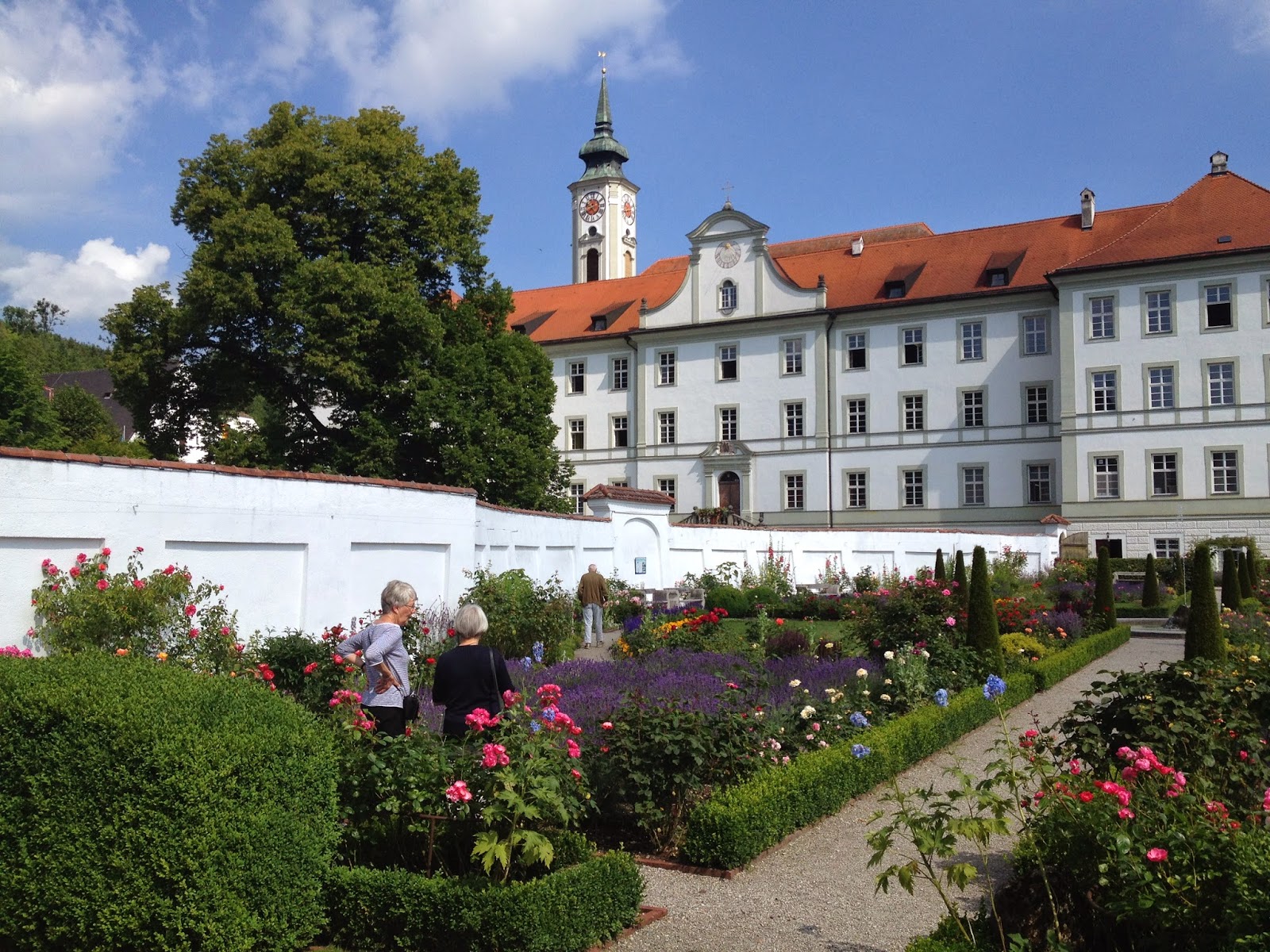Munich was our last—and longest—stop, as it
remains one of our favorite cities, which we have visited often. The Consulate General was Todd’s
first Foreign Service post, and a number of friends date from that time, now 50
years in the past. We were
fortunate to find a hotel in Unterhaching, a southeast suburb with good stores
and restaurants. With an S-Bahn
station a five-minute walk away, we could be in Marienplatz, the heart of
Munich, in less than half an hour.
Sicilian restaurant where we dined in Unterhaching
Marienplatz
"New" Rathaus on Marienplatz
The weather improved later during our visit,
but rain dogged us during a three-day excursion to the Allgäu, a vacation area
southwest of Munich. There
we were the guests of Joachim and Irene von Feilitzsch, who have a vacation
home at the foot of the Alps. We
were able to ride up into the mountains one day before lightning closed the
cable car. The next day was spent
touring nearby sights, including Linderhof, our favorite of “mad” King Ludwig
II’s castles, for its smaller scale makes it seem more livable despite its
Baroque ostentation. Nonetheless,
Ludwig spent few nights there.
View from balcony at von Feilitzsch vacation home
With Joachim and Irene in the Alps
Linderhof Castle
Dining in Munich was a treat with food varying
from Bavarian specialties to haute cuisine. We went one evening to a forest gasthof outside
the city, where the Bavarian fare was complimented by an herb salad with an extraordinary
dressing, the best we had eaten during our travels. This course was followed by a delicious sorbet made from
(Georgia guessed correctly) celery and apples. Ben and Jerry, take note!
With Dirk and Frauke Müller outside Forsthaus Kasten
For our Big Night Out, we dined at the Halali,
a small upscale game restaurant behind the U.S. Consulate General which Vice
Consul Stewart enjoyed when he could afford it. The food, service, and atmosphere (e.g., chamois horns on
the walls) were as good as he remembered.
After dinner we walked to the royal Residenz for a performance of opera
selections in the Cuvilliés-Theater, a Baroque jewel seating just a few hundred
people. The young
performers, including three Americans, acted as well as sang in an engaging
ensemble esprit.
Royal box at Cuvilliés-Theater
Marienplatz by night
The Cuvilliés-Theater performance was followed
a few day later by La Bohème,
performed in what the producers claim is Munich’s smallest opera stage, a
raised platform in the corner of the grounds of a former monastery. The 10-piece orchestra was seated
under an awning in case of rain, but the action was not restricted to the stage
as singers popped up in the audience and an adjoining part of the monastery wall. While costumes were basic and there
were no sets, the singing was excellent, particularly Mimi, an American soprano.
Frauke with La Bohème tickets
As the weather improved, we were able to make
further excursions out of town.
Our good friends Dirk and Frauke Müller drove us to see Herrenchiemsee,
King Ludwig’s copy of Versailles (his Hall of Mirrors is actually longer than
Louis XIV’s) reachable by ferry in the middle of the Chiemsee, a lake southeast
of Munich. The following day
more good friends, Peter and Gisela Wild, took us south of Munich to visit the
Schäftlarn Monastery, whose beautiful garden rivals its Baroque interior; a
museum devoted to Franz Marc; and a house Vassily Kandinsky shared with fellow
artist Gabriele Münter before World War I. (Kandinsky’s art from that period is in a Munich museum, but
the house contains furniture painted by Kandinsky in a Bavarian country
style.) Another highlight of that
second trip was lunch in a restaurant overlooking the Walchensee, an Alpine
lake near the Austrian border, which provided the fish for our meal.
Herrenchiemsee Palace
Schäftlarn Monastery
Walchensee
With Peter and Gisela at Walchensee restaurant
Elmau resort, site of G-7 (or maybe G-8) summit in 2015
We were in Bavaria during the final rounds of
the World Cup, when every German’s eyes were focused on telecasts from
Brazil. To say that football fever
gripped the country would be an understatement, for the black-red-and gold
federal flag flew from homes, cars, and bicycles. (This was all the more significant in Bavaria, where the
state’s white-blue flag is usually more prevalent than the national
banner.) We happened to be in
Schweinfurt, in northern Bavaria, visiting our good friends Fritz and Mary
Ritzmann the night of the final (Germany vs. Argentina if you were living in a
cave) so we watched with our hosts, their five children, Mary’s sister Anna,
and her daughter. When
Germany won in overtime, we opened the house doors to hear the celebratory
noise coming all the way from downtown Schweinfurt.
Car of German soccer fan
With Ritzmann family for the World Cup final match


















